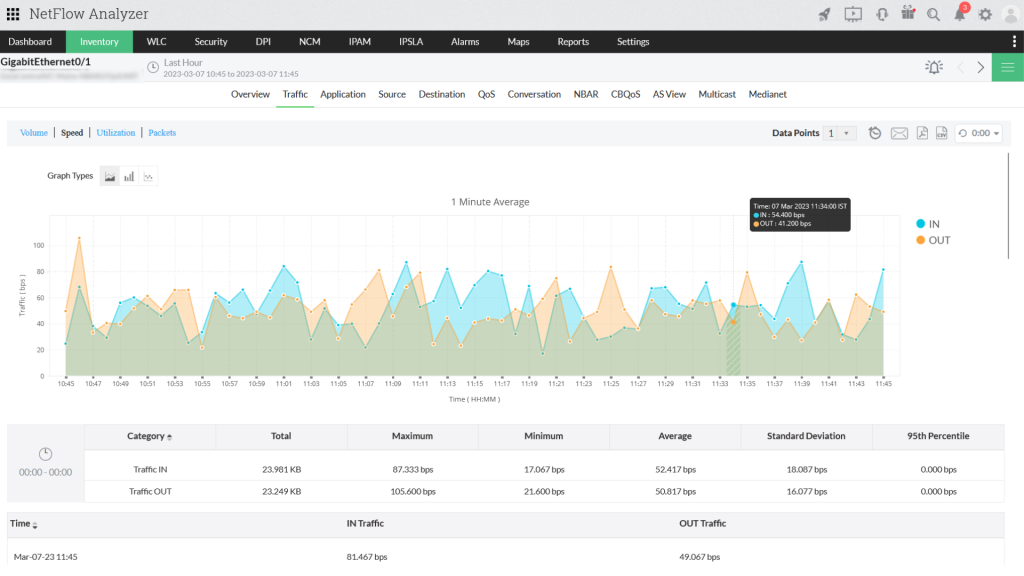Enterprises that want to improve the performance of their network often look into limiting access to bandwidth-hogs such as social media and video streaming applications. But for those that really need to gain efficient network, this won’t be enough. You need to keep track of bandwidth usage regularly.
While there are many tools to help you check bandwidth usage on network, sometimes finding KPIs specific to your organization can be painstaking. Compiled below are a set of tips that can help you carry out bandwidth usage monitoring for your enterprise network, without requiring a day-to-day monitoring strategy.
Perform application-level analysis
Analyzing network traffic on an application level helps in determining where the bandwidth is being allocated. Some applications can be enterprise-specific, which can differ from the usual port-protocol combination followed by IANA. On the other hand, some applications use dynamic ports to handle the traffic-accessing applications. To know whether your enterprise traffic is used rightfully for business purposes or not, you need to check the top talkers consistently, then determine whether those applications should be accessing the network.
Calculate bandwidth demands
Irrespective of your business’s nature, one important aspect you need to assess is whether the bandwidth you’ve purchased is meeting your users’ demands. While you can add more bandwidth to your existing capacity, it’s best to avoid frequent major upgrades. For this, you can start with monitoring the number of bytes per second of traffic that each application or IP address is generating in your network.
Monitor device traffic
The most important step in determining how your network is performing is to measure the traffic volume and types of devices connected to your network. Especially in growing enterprises, wireless network devices such as access points can take up most bandwidth. Access points are of particular concern due to the number of users simultaneously using the bandwidth, which can invite a lot of harmful traffic. Such metrics can help in finding which devices are taking up the majority of bandwidth, and how you can distribute the bandwidth for a better user experience.
Scan for unusual traffic spikes
On a typical business day, the enterprise’s network can face occasional traffic spikes. However, an untimely traffic spike representing a flood of business requests can be a DoS/DDoS attack. What can start as a seemingly normal traffic spike might bring all your business operations to halt and attack the security surface of your organization’s network.
Thus, it is necessary that you monitor every interface that is reaching its maximum utilization and detect their behavior. This will help you determine which users are accessing those interfaces, and in what way they are using your network. Though tools like firewalls can be beneficial in these cases, the advanced attacks such as zero-day threats won’t fit the predefined security rules. You need a network behavior analysis and detection tool to detect those suspicious flows.
Group the elements
For any medium or large-sized businesses, its network can consist of hundreds or thousands of devices and interfaces. With such a large network, it will be too difficult to check bandwidth usage on network of every interface or device, while ensuring those elements are not exceeding bandwidth limits.
It’s always best to group the elements such as IP addresses or applications or access points based on their departments or branches, then cross-check the network traffic transmitted and received by them. You can later drill down to check how each IP address or application is using your bandwidth. By segmenting the elements, you will be able to allocate the bandwidth based on needs, and isolate any particular group if there’s an attack.
Define thresholds
Often an organization will aim to keep its network at optimal functionality, and relying on alerting features is a great way to stay on track. For keeping your company’s intranet at the baseline behavior, you can choose a bandwidth monitoring tool. A network bandwidth usage checker lets you set the threshold for your corporate network’s normal bandwidth usage. Therefore, you will know the performance and health, while still being able to concentrate on checking bandwidth usage on network and troubleshooting important issues.
Bandwidth monitoring refined, with NetFlow Analyzer!
Modern problems require modern solutions. With network complexities increasing every day, enterprises need a holistic solution that can help in following all the strategies outlined above. The tool they rely on should be easy to integrate in their infrastructure, and have minimum requirements.

Developed specifically to address these evolving IT performance management challenges, ManageEngine NetFlow Analyzer offers you the ease of bandwidth monitoring. NetFlow Analyzer is a full-fledged bandwidth usage checker that provides you insights on your enterprise’s bandwidth usage. With our flow-based tool, you can find the traffic information by IP address, ports, protocols and conversations, and shape bandwidth specifically for your business purposes.
Check out how enterprises have benefited with NetFlow Analyzer with these case studies.